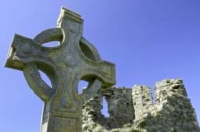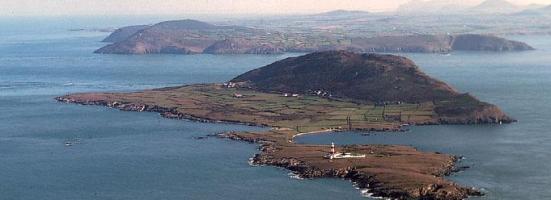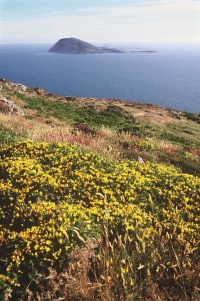
Enlli/Bardsey
According to tradition, Bardsey Island is the burial place of 20,000 saints and the last resting place of King Arthur and Merlin. It has a long history as a place of pilgrimage and worship, and today is an important conservation site.
Lying in the Bardsey Sound, two miles off the tip of the Llyn Peninsula in Snowdonia, Bardsey Island is a mile and a half in length and half a mile wide at its widest point. Yet despite its diminutive size, Bardsey – in Welsh, Ynys Enlli, which means ‘island of the tides’ – is a site of considerable significance in Snowdonia’s history and spirituality, and has been so for at least 1,500 years.
The earliest settlers made Bardsey their home some 2-3,000 years ago, and the remains of their circular huts can be seen on a small sheltered terrace on the island’s mountain, Mynydd Enlli. In the 6th century the Breton saint, St Cadfan, established a monastery on Bardsey, and the island flourished as an important place of pilgrimage. With 20,000 saints said to be buried on the island, by the early middle ages three pilgrimages to Bardsey were deemed as beneficial to the soul as one to Rome.
Throughout the middle ages the island retained its status as an important place of pilgrimage, and in the 13th century an Augustinian abbey – St Mary’s – was built, remaining in use until the dissolution of the monasteries in 1537. The abbey’s roofless tower is the oldest standing building on the island, and is still used for informal services today.

Bardsey/Enlli
In the mid-18th century a farming and fishing community was established on Bardsey, and this period of the island’s history continued into the 20th century. In 1979 the Bardsey Island Trust bought the island, and continues to manage and protect Bardsey in conjunction with the Countryside Council for Wales and CADW. Today, Bardsey Island is a National Nature Reserve (NNR) and Site of Special Scientific Interest (SSSI).
Bardsey’s NNR and SSSI statuses reflect the significance of the island’s natural history. Bardsey is home to many rare plants, including western clover and small adder’s tongue, and there are over 350 species of lichen living on the island. Bird life is diverse; birds seen on Bardsey include choughs, oystercatchers, herons, peregrine falcons, wheatears, warblers and little owls. Sea birds include gannets, razorbills and shags, and evidence suggests puffins are also colonising the island. The most famous birds on Bardsey, however, are Manx shearwaters; there is a breeding colony of 10-16,000 birds on the island.
Sea life is also rich and varied in the waters surrounding Bardsey; in the rock pools anemones and crabs are plentiful, while in the deeper waters there are sponges and sea-squirts. Yellow star anemones, which usually live in the Mediterranean Sea, are found in the sea around Bardsey. Atlantic grey seals can be seen in the rocky bays – a small number breed on the island each year – and Risso’s dolphins and harbour porpoises are often seen in the island’s surrounding waters.

Enlli (Bardsey) from Uwchmynydd
Effective land management on Bardsey is essential for sustaining the special environment which is so important for sustaining the special wildlife on the island. Oats, turnips and swedes are grown here, providing winter feed for the island’s livestock, encouraging arable weeds, and providing cover and food for the migrant and resident birds. Fishing also remains important; the sea around the island is still regularly fished for lobster and crab, which are sold on the mainland.
Bardsey is home to the world’s rarest apple, Afal Enlli (Bardsey Apple). An apple tree on the island – possibly the only survivor from an ancient orchard, dating back some 1,000 years – was discovered some years ago to be growing a variety of apple not found anywhere else in the world. Visitors to the island can now buy their own young Afal Enlli trees and take them home as a souvenir of their trip.
As well as having a notable place in history and being an important wildlife site, Bardsey is a significant location in the myths and legends of Snowdonia. Some say that Bardsey is the mysterious Isle of Avalon from the Arthurian legends, and that King Arthur’s ship lies at the bottom of the Bardsey Sound (Arthur himself sleeps in a cave on the island, awaiting the day of Britain’s direst need, when he will rise up to save his land). Other stories say that Merlin, Arthur’s magician, sleeps in a magical glass castle on Bardsey, surrounded by the Thirteen Treasures of Britain and attended by nine bardic companions.
Significant throughout history and mythology, a special place spiritually and environmentally, and today, attracting a new breed of pilgrims – tourists – Bardsey has a unique charm and wide appeal that cleaves the island to the hearts of visitors and residents alike. If you’re visiting Snowdonia and would like to experience Bardsey’s wild serenity for yourself, you can find out more about day trips and overnight stays by visiting www.enlli.org.
Pingback: North Wales James Braid Golf Trail: Nefyn And District Golf Club « Snowdonia Mountains and Coast
Pingback: Ten Things To Do In And Around Aberdaron « Snowdonia Mountains and Coast
Pingback: Romantic Snowdonia: Ten Places To Enjoy Romantic Views « Snowdonia Mountains and Coast
Pingback: Visiting the Llŷn Peninsula: Aberdaron, Abersoch and Pwllheli | Snowdonia Mountains and Coast
Pingback: Snowdonia For Beginners: Four Things Worth Knowing About Snowdonia | Snowdonia Mountains and Coast
Pingback: Eryri i Ddechreuwyr: Pedwar o Bethau Gwerth eu Gwybod am Eryri | Ymweld ag Eryri
Pingback: Following The Pilgrim’s Way In Snowdonia | Snowdonia Mountains and Coast
Pingback: Dilyn Ffordd y Pererin Yn Eryri | Ymweld ag Eryri
Pingback: Father’s Day in Snowdonia: great ideas for every type of dad! | Snowdonia Mountains and Coast
Pingback: Sul y Tadau yn Eryri: syniadau gwych ar gyfer pob math o dad! | Ymweld ag Eryri
Pingback: Eight characters in history and folklore with connections to Snowdonia | Snowdonia Mountains and Coast
Pingback: Wyth cymeriad mewn hanes a llên gwerin gyda chysylltiadau i Eryri | Ymweld ag Eryri